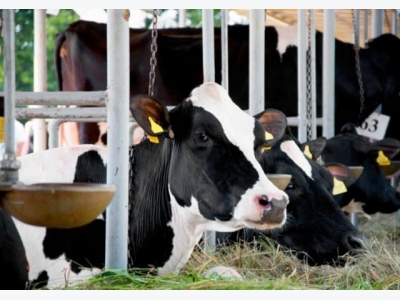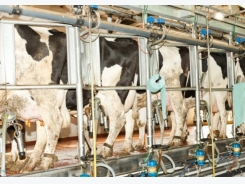Can methionine supplements support cattle pregnancy?

Methionine supplementation in cows may improve embryonic traits, survival conditions, say a group of US and Brazilian animal scientists.
A team of researchers at the University of Illinois in the US and the Universidade Federal de Pelotas in Brazil examined the use of methionine and choline supplements with cattle to see how they might affect pregnancy. The team published their report in the journal Theriogenology.
The group focused on use of the feed additives during the pre-partum and postpartum stages, members said.
“We wanted to assess how the nutrient would affect the fertility of the cows, [and] we looked at the embryos that came from cows supplemented,” said corresponding author Phil Cardoso, in the department of animal sciences at the University of Illinois.
The group found that embryos from the cattle getting the supplements had additional lipid content, and there is evidence that the additional lipid reserves generated through the supplementation may enhance an embryos chance for survival by offering an energy substrate, said the researchers.
However, additional research is needed to better understand what role those lipids might play in pregnancy development and in calves, Cardoso told us.
Why methionine and choline?
Past research has established a link between animal nutrition and fertility, said the researchers. In other species, studies has explored the use of supplemental amino acids to improve embryonic and fetal survival.
Methionine is a limiting amino acid in cattle diets, but it has to be protected to survive the rumen, said Cardoso. Choline is nutrient also needed by the animals.
“The specific thing about methionine is it is the most limiting amino acid,” he said. “She [the cow] cannot build proteins without methionine, [and] she can produce more protein if you supplement methionine.”
Methionine is used by the cow to produce methylation at the cellular level, he said.
Cardoso said one of the questions the team behind the research asked was if the amino acid acts as a limiting agent, what benefits might be seen if it the amount fed was increased.
Choline supplementation was added to the study because the nutrient also can act as a methyl donor, he said.
DNA methylation is a pathway for the regulation of gene expression and silencing, said the researchers. And it may play a part in transcription.
“Our rationale was if methionine is limiting, maybe that process could be affected as well,” said Cardoso.
Trial details
In the trial 36 cattle went through two stages of supplementation, said the researchers. In the first section, multiparous cows were assigned to one of four diets starting about 21 days before calving through 30 days in milk (DIM).
The test diets were MET, which included a basal diet with rumen-protected methionine at 0.08% of the dry matter; CHO, the basal diet with choline 60g/d; MIX, which was supplemented with both methionine and choline; and CON the control diet, which had no supplementation, they said.
The second phase of the trial ran from DIM 31 through 72, they said. The cattle were recombined into one of two groups at this stage with one group, SMT, receiving the basal diet and 0.08% of the dry matter intake as methionine and the other diet CNT acting as a control with no supplementation.
Ovulation was induced in the cattle on day 66 and cattle were artificially inseminated, said the researchers. Embryos were flushed 6.5 days after insemination for methylation, lipid and cellular assessment.
Dry matter intake was recorded during the dry period and for 72 days post calving, they said. Body weight and body condition scores (BCS) were recorded weekly.
Results
Cattle body weight and dry matter intake were not altered by the treatments, said the researchers. BCS for weeks 5-10 were dissimilar with the CON-CNT group having the lowest score and the CON-SMT the highest.
There were no differences found between the embryos for several categories examined, the researchers said. Embryos recovered, embryo quality, stage and number of cells per embryo, were the same for the different groups.
The number of (corpora lutea) CL did have a reaction by treatment group with cows getting the MET-SMT and MIX-SMT having larger numbers than the MIX-CNT group, they said.
Methylation did show some differences, said the researchers. Embryos from cattle that had not received any supplements, CON-CNT, had more methylation than those from cattle getting the methionine supplements and then having them removed did.
The result was surprising said Cardoso because the group was expecting to see an increase in methylation. The team may need to refine how it examines the methylation process.
“I think we may have to be more specific,” he said. "The global methylation is maybe not the best way to look at it.”
The process also may be easier to examine in an older or larger embryo, he added.
Although the cytoplasmic lipid content did not alter by diet group, the lipid content was higher for supplemented cows than the control group, they said.
What’s next?
The group is working to understand what may have caused additional lipids accumulation and what role they may play in embryo development, said Cardoso. “We have several theories why that is happening,” he added.
It may be that with the supplemental methionine the cow has enough to use in this manner, he said.
Two theories regarding why the embryos developed additional lipids were that they could act as an additional energy source for the embryos to increase chances of survival, he said. Or, the lipids may play a role with membrane interface.
One next step for the team’s research will be to examine the lipids deposited and see what changes have been made to the fatty acids, which could provide more information about their actions, said Cardoso. The group also took uterine biopsy samples and will examine how those match with the embryonic tissue.
There also may be work future done to examine what the feed supplement might mean throughout the gestational period and in early life, he said.
Có thể bạn quan tâm
Phần mềm

Phối trộn thức ăn chăn nuôi

Pha dung dịch thủy canh

Định mức cho tôm ăn

Phối trộn phân bón NPK

Xác định tỷ lệ tôm sống

Chuyển đổi đơn vị phân bón

Xác định công suất sục khí

Chuyển đổi đơn vị tôm

Tính diện tích nhà kính

Tính thể tích ao hồ



 Supplemental solids boost dairy heifer early growth
Supplemental solids boost dairy heifer early growth  Pelleted, treated feeds may boost digestion in growing…
Pelleted, treated feeds may boost digestion in growing…